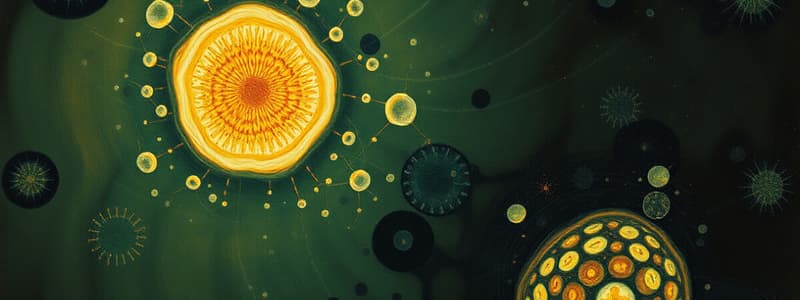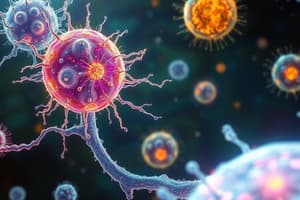Podcast
Questions and Answers
What is the cell theory?
What is the cell theory?
- All living things are composed of cells. (correct)
- Cells are the basic units of structure and function in living things. (correct)
- New cells are produced from existing cells. (correct)
- None of the above.
What are the characteristics of prokaryotes and eukaryotes?
What are the characteristics of prokaryotes and eukaryotes?
Prokaryotic cells have genetic material not contained in a nucleus, while eukaryotic cells contain a nucleus.
What is the basic unit of life?
What is the basic unit of life?
Cell
What is cell theory?
What is cell theory?
What is the nucleus?
What is the nucleus?
What is a eukaryote?
What is a eukaryote?
What is a prokaryote?
What is a prokaryote?
What are organelles?
What are organelles?
What is cytoplasm?
What is cytoplasm?
What does the nucleus contain?
What does the nucleus contain?
What is the nuclear envelope?
What is the nuclear envelope?
What is chromatin?
What is chromatin?
What is a nucleolus?
What is a nucleolus?
What are ribosomes?
What are ribosomes?
What is the endoplasmic reticulum?
What is the endoplasmic reticulum?
What is the golgi apparatus?
What is the golgi apparatus?
What are vacuoles?
What are vacuoles?
What are mitochondria?
What are mitochondria?
What are chloroplasts?
What are chloroplasts?
What is the cytoskeleton?
What is the cytoskeleton?
What are centrioles?
What are centrioles?
What is the main function of the cell membrane?
What is the main function of the cell membrane?
What is the main function of the cell wall?
What is the main function of the cell wall?
What happens during diffusion?
What happens during diffusion?
What is osmosis?
What is osmosis?
What is the cell membrane?
What is the cell membrane?
What is the cell wall?
What is the cell wall?
What is a lipid bilayer?
What is a lipid bilayer?
What is concentration?
What is concentration?
What is diffusion?
What is diffusion?
What is equilibrium?
What is equilibrium?
What is a hypertonic solution?
What is a hypertonic solution?
What is a hypotonic solution?
What is a hypotonic solution?
What is isotonic solution?
What is isotonic solution?
What is facilitated diffusion?
What is facilitated diffusion?
What is active transport?
What is active transport?
What is endocytosis?
What is endocytosis?
What is phagocytosis?
What is phagocytosis?
What is pinocytosis?
What is pinocytosis?
What is exocytosis?
What is exocytosis?
What is cell specialization?
What is cell specialization?
What are the 4 levels of organization in multi-cellular organisms?
What are the 4 levels of organization in multi-cellular organisms?
What is tissue?
What is tissue?
What is an organ?
What is an organ?
What is an organ system?
What is an organ system?
Flashcards are hidden until you start studying
Study Notes
Cell Theory and Basics
- All living things are composed of cells, which are the fundamental units of structure and function.
- New cells arise from existing cells, forming the basis of cell theory, a core biological principle.
Prokaryotes vs. Eukaryotes
- Prokaryotic cells: Lack a nucleus, have genetic material distributed throughout the cell.
- Eukaryotic cells: Contain a nucleus that encapsulates genetic material (DNA).
Cell Structures
- A cell is defined as the basic unit of life.
- The nucleus is a larger membrane-bound organelle housing the cell's DNA.
- Organelle refers to "little organs," specialized structures within the cell, such as mitochondria and chloroplasts.
Nucleus and Genetic Material
- The nuclear envelope consists of two membranes surrounding the nucleus, serving as a barrier.
- Chromatin is granular material within the nucleus, primarily made of tightly coiled DNA and proteins.
- The nucleolus, located within the nucleus, is responsible for ribosome assembly.
Protein Synthesis
- Ribosomes are small particles where protein assembly occurs; they are composed of RNA and proteins.
- The endoplasmic reticulum is an internal membrane system where lipid components and protein modifications occur.
- The Golgi apparatus modifies, sorts, and packages proteins for transport.
Cellular Metabolism
- Mitochondria convert chemical energy from food into usable compounds for the cell.
- Chloroplasts, present in plant cells, capture sunlight to produce chemical energy through photosynthesis.
Cell Support Structures
- The cytoskeleton is a network of protein filaments that provides structural support and facilitates cell movement.
- Centrioles, located near the nucleus in animal cells, play a role in cell division.
Cell Membranes
- The cell membrane is a flexible barrier controlling the passage of substances in and out of the cell, providing protection and support.
- The cell wall, found in plants, fungi, and some bacteria, offers additional support and protection around the cell membrane.
Molecular Transport Mechanisms
- Diffusion is the movement of molecules from areas of higher concentration to lower concentration, occurring without energy expenditure.
- Osmosis specifically refers to the diffusion of water through a selectively permeable membrane.
- Facilitated diffusion employs protein channels for specific molecule transport across membranes.
Concentration and Equilibrium
- Concentration measures the mass of solute in a given solution volume.
- Equilibrium occurs when solute concentrations are equal throughout a system.
Solution Conditions
- Isotonic solutions have equal concentrations on both sides.
- Hypertonic solutions have higher solute concentrations outside the cell, leading to potential cell shrinkage.
- Hypotonic solutions have lower solute concentrations outside the cell, which may cause the cell to swell.
Active Transport and Vesicular Transport
- Active transport requires energy to move materials against concentration gradients.
- Endocytosis involves cell membrane pockets engulfing materials; phagocytosis refers to "cell eating," while pinocytosis involves liquid uptake.
- Exocytosis allows cells to release large amounts of material into the exterior.
Cell Specialization and Organization
- Cell specialization permits diverse cell types to develop and perform specific tasks.
- The organization levels in multicellular organisms are: cells, tissues, organs, and organ systems.
- Tissues consist of similar cells performing particular functions, while organs are collections of tissues working in tandem. Organ systems are groups of organs collaborating to fulfill specific biological roles.
Studying That Suits You
Use AI to generate personalized quizzes and flashcards to suit your learning preferences.




